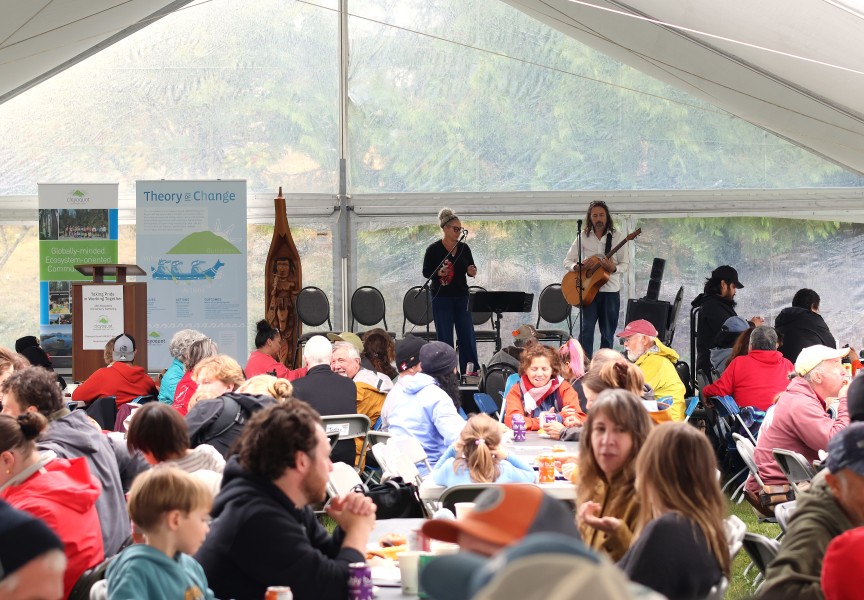~ B.C. is the only one of 10 provinces that does not have a child poverty plan in place
~ One out of five B.C. children lives in poverty
~ The poverty rate in the Alberni Valley] is 18.5 per cent, 26 per cent higher than the national average
The experts delivered the message with statistics and Nuu-chah-nulth members stood up to confirm it: “Yes. Poverty is debilitating and degrading and it causes long-term health effects. And we are the living proof.”
The two-way dialogue took place at the Community Forum on Poverty on Nov. 24 at the Port Alberni Friendship Centre. The event was hosted by Alberni-Pacific Rim MLA Scott Fraser, in partnership with the Alberni Valley Community Foundation and the Alberni Valley Health Network.
Fraser said the forum was organized following the release of the Alberni Valley Vital Signs Report, which delivers a bleak picture of numerous social conditions resulting from high unemployment and low incomes.
“Our office has been dealing with issues of poverty for a long time,” Fraser said.
The MLA noted that, earlier that day, the B.C. Child and Youth Advocacy issued a damning report, First Call, on child poverty rates in the province. According to First Call, one out of five B.C. children lives in poverty – arguably the highest rate in Canada.
“It’s a stark reminder that we have a problem. And we have a problem right here in the Valley. So it’s time to find solutions,” Fraser said. “These reports should not be collecting dust. They should be calls to action.”
See Part Two: http://www.hashilthsa.com/news/2015-11-30/nuu-chah-nulth-members-speak-o...
On that point, there was wide agreement. Along with the MLA, the event drew newly-elected NDP Member of Parliament Gordon Johns, Port Alberni Mayor Mike Ruttan, Alberni-Clayoquot Regional District Chair Josie Osborne and a host of community leaders.
The first presentation came from Dr. Paul Hasselback, Chief Medical Officer for Island Health, who opened with a diagram of Determinants of Health.
“This really should be called ‘Determinants of Living,” he suggested. “Number one on this list is ‘Economic Status.’”
In short, how much you make has a major effect on your health, Hasselback said. All diseases are exacerbated by poverty, whether it is the result of poor housing, poor nutrition, poor working conditions or any number of related issues.
“Heart disease, stroke, you name it. The more you are economically challenged, the more likely you will have these diseases,” he said. Statistically, the rates are 1.5 to two times higher than for middle- to high-income persons.
Above all the many statistics, Hasselback had one consistent message: “If we address poverty, everybody will be better off.”
Tellingly, he said B.C. is the only one of 10 provinces that does not have a child poverty plan in place.
Unfortunately, Hasselback said, the generation of people who are just entering the workforce are often saddled with high student debt, high rents and low-wage employment with few benefits, if any. The effect is to create systemic poverty.
The solution, he said, is to take action, politically and as a community.
“What I would like you to recognize is that you can actually do something. Poverty is not a massive problem that none of us can address,” he concluded, urging participants to join together, to form action groups and to become part of a community solution.
Port Alberni Shelter Society President Wes Hewitt said that, on the surface, the Alberni Valley’s low housing prices and low vacancy rates look pretty good compared to provincial averages. But those statistics are misleading, he said.
“Housing is directly tied to income,” Hewitt explained. If you are living on Old Age/Canada Pension, on income assistance or disability, not to mention working a low-wage job, you are virtually guaranteed to be spending more than 30 per cent of your income on housing. That puts you in the hole right from the start.
“The poverty rate [in the Alberni Valley] is about 18.5 per cent. That’s about 26 per cent higher than the national average,” Hewitt said. “Twenty six per cent of our community spends more than 30 per cent of their income for housing.
“According to the statistics, we have a critical shortage of affordable housing.” Much of the housing that is available was built in the 1960s and has been poorly maintained, he added.
Noting the federal, provincial and local government politicians in the house, Hewitt said it will take political action at all levels to improve the housing picture in the Alberni Valley.
To reinforce the point, he put up a slide outlining every social housing project built by the B.C. Housing Corporation over the past five years. Not one project has been built in the Alberni Valley, although Port Alberni Mayor Mike Ruttan advised that the city has made strong representations to the province to address that deficiency.
Stacey Manson, among her many duties at School District 70, runs the Strong Start program for parents and preschoolers.
“Poverty does not play favorites. We know poverty is in every one of our schools in our district,” Manson said.
The challenge for educators is to provide supports and early interventions for families and children in those critical early years when the child’s brain is developing rapidly.
Poor children may be malnourished and they are more likely to have hyperactivity disorder or emotional difficulties, Manson said.
Children who bring vulnerabilities to school, if they do not receive the appropriate interventions, can be expected to perform poorly. They may fall victim to addictions, criminal behavior or sexual abuse. As they grow older, they are more likely to develop obesity and/or heart disease.
“Their life trajectory can be affected before they even come to school,” Manson said. Providing emotional support at an early age is actually more important than academic support.
Hungry children don’t learn well. Valley schools provide a number of breakfast and lunch programs. At ADSS, as many as 200 students per day grab a quick breakfast or snack to get them through the day. The high school also offers emergency clothing, food and school supplies on an as-needed basis.
Supports are good and necessary, but the only permanent solution to child poverty is to provide jobs that pay enough to provide the necessities of life, according to Deanna Ogle, campaign organizer for the Living Wage For Families campaign.
Ogle pointed out that in B.C., the poverty rate for First Nations children is actually 48 per cent. To properly support a family of four, both parents need to earn at least $17.22 an hour. She called on participants to challenge government at all levels to make that living wage a matter of public policy.
“What we need is not only jobs, but good jobs,” Ogle said. “Each one of us has a role in ending poverty in our community.”
That was a message emphasized by Minnie Hornidge, United Church minister and president of the Bread of Life Society.
“We are about to enter into creative engagement,” she began. “Maybe if we can come up with a Poverty Reduction Strategy, we can bring it to the province.”
Hornidge said her two main concerns are food and housing, noting that the Bread of Life serves “a lot of meals,” five days a week.
“There’s community kitchens, there’s food banks, there’s community gardens. What is the next step? I believe there should be a community garden in every neighbourhood. I believe people could donate property they are not using, for a community garden in their neighbourhood that builds relationships.”






